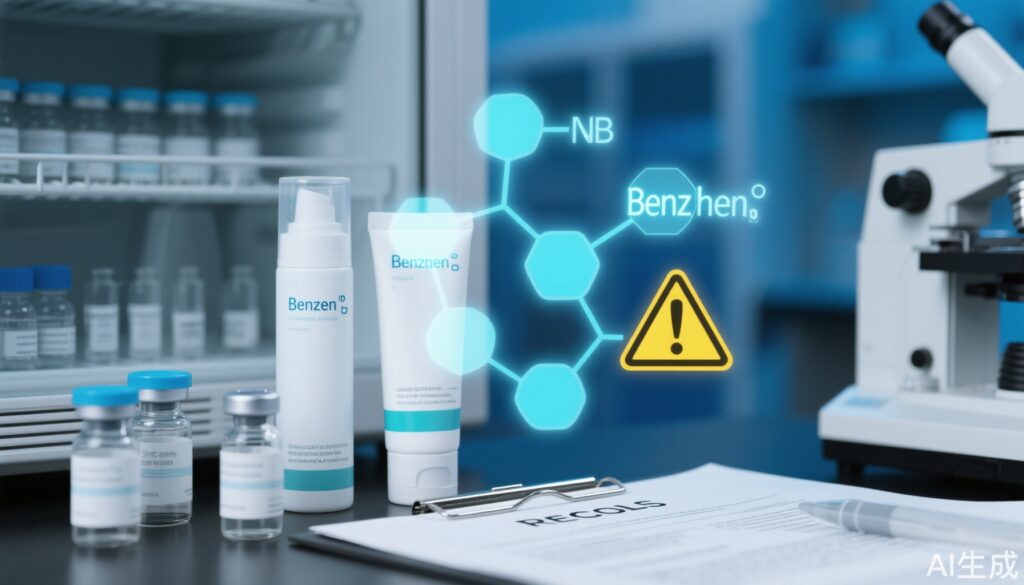Highlights
- Independent laboratory testing revealed high levels of benzene, a carcinogen, in several benzoyl peroxide acne products, far exceeding the FDA’s acceptable limit.
- The FDA and manufacturers responded with recalls and public advisories, but debate remains regarding the adequacy of current regulatory actions.
- Recent studies suggest that storage conditions, especially temperature, and product formulation influence benzene formation.
- Despite benzene concerns, there is currently no epidemiological evidence linking benzoyl peroxide acne treatment to increased benzene-related cancer risk.
Clinical Background and Disease Burden
Acne vulgaris is one of the most prevalent dermatological conditions worldwide, affecting up to 85% of adolescents and a significant proportion of adults. Benzoyl peroxide (BPO) has been a mainstay in topical acne therapy for decades, valued for its antimicrobial, keratolytic, and anti-inflammatory properties. For many patients—especially those with mild to moderate acne or antibiotic resistance—BPO represents the only effective topical therapy. Given its widespread use, any concerns regarding product safety have potentially broad public health implications.
Recent Events and Regulatory Response
In March 2024, an independent laboratory, Valisure, filed a citizen’s petition to the FDA after detecting benzene in BPO-containing acne products at levels reportedly exceeding the agency’s conditional limit of 2 parts per million (ppm)—sometimes by over 800-fold. Benzene is a well-established human carcinogen, primarily linked to hematologic malignancies, and its presence in over-the-counter (OTC) products is strictly regulated. The petition ignited diverse reactions, from alarm among consumers to skepticism among some clinicians, with several dermatologists initially dismissing the findings as overblown.
Following these concerns, the FDA tested 95 acne products containing BPO. In March 2025, results prompted voluntary recalls by six companies, with additional recalls for products confirmed to contain excessive benzene through independent testing. The FDA also issued public alerts and guidance to manufacturers and consumers regarding benzene contamination risks.
Research Methodology and Key Findings
The Valisure analysis employed headspace gas chromatography-mass spectrometry to quantify benzene levels in commercial BPO products. Results revealed a wide range of contamination, with some products containing benzene concentrations more than 800 times the FDA’s conditional limit. Importantly, the formation of benzene appeared to be influenced by storage temperature and product type.
A May 2025 study by Bunick, Light, et al., published in JAMA, demonstrated that cold storage of BPO products significantly reduced benzene formation, implicating temperature-dependent degradation as a key factor. Another study, co-authored by Barbieri, found that leave-on BPO products generally contained lower benzene levels than wash-off formulations, possibly due to smaller batch sizes and faster cooling during manufacturing.
Despite the presence of benzene, a multicenter retrospective analysis by Veenstra et al. (J Am Acad Dermatol, 2025) found no significant association between BPO acne treatment and benzene-related cancers, providing some reassurance in the absence of long-term epidemiological evidence of harm.
Mechanistic Insights
BPO is a known oxidizing agent that can break down under heat and light, potentially generating benzene as a degradation byproduct, especially in poorly controlled storage or manufacturing settings. The risk of benzene formation appears to be minimized by cold storage and rapid post-production cooling, as demonstrated in recent research. Formulation differences—such as leave-on versus wash-off products—may also affect the extent of benzene generation, highlighting the importance of manufacturing and storage protocols.
Expert Commentary
Dr. John Barbieri, a noted dermatologist and co-author on recent studies, emphasized, “We want to be doing as much as we can to mitigate the risk as much as possible. Even if the risk is 0.00001, if we can make it zero, we should make it zero.” This sentiment reflects a growing consensus among experts that while the absolute cancer risk from incidental benzene exposure in BPO products appears low, any preventable exposure to a carcinogen in consumer products is unacceptable—especially when mitigation strategies are feasible.
Controversies and Limitations
There remain several points of debate within the medical and regulatory communities. Some experts argue that the FDA’s response—relying on voluntary recalls and industry guidance—has been insufficiently stringent, given the potential for population-level exposure. Others note the lack of direct evidence linking BPO use to increased cancer incidence, cautioning against overreaction that could remove an essential acne therapy from the market.
Additionally, most studies to date have focused on product analysis and retrospective epidemiology, often lacking granular exposure data or long-term follow-up. The exact threshold at which benzene in topical products poses a substantial health risk remains uncertain, and the generalizability of findings to all BPO-containing products is limited by variability in formulation and supply chain management.
Conclusion
The detection of benzene in BPO acne products has catalyzed regulatory action, industry recalls, and ongoing scientific investigation. While current epidemiological data do not indicate a measurable increase in benzene-related cancers among users, the principle of minimizing exposure to known carcinogens remains paramount. Improvements in manufacturing, storage, and regulatory oversight—such as mandatory cold-chain logistics and batch testing—could further reduce risk. Meanwhile, clinicians should remain informed, counsel patients appropriately, and advocate for continued monitoring and research to ensure the safety of widely used dermatologic therapies.
References
Yang K, Bunick CG, Jafarian F. A Justification to Using the FDA Adverse Event Reporting System for Hypothesis Generation Regarding Benzoyl Peroxide. J Invest Dermatol. 2025 Jul 7:S0022-202X(25)00559-7. doi: 10.1016/j.jid.2025.05.032. Epub ahead of print. PMID: 40633753.
Dhawan S, Nardo CJ. The Impact on Acne Treatment Regimens if Benzoyl Peroxide-Containing Products are Removed From the Market. J Drugs Dermatol. 2025 Jun 1;24(6):586-589. doi: 10.36849/JDD.8840. PMID: 40465500.
Veenstra J, Ozog D, Stephens A. Benzoyl peroxide acne treatment shows no significant association with benzene-related cancers: A multicenter retrospective analysis. J Am Acad Dermatol. 2025 Jun;92(6):1440-1442. doi: 10.1016/j.jaad.2025.02.038. Epub 2025 Feb 20. PMID: 39986390.


